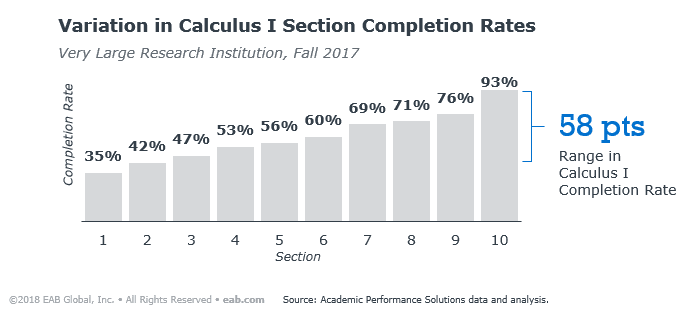It matters who is teaching your 101 classes—and how
High failure rates in critical gateway courses are one of the biggest (and often under-prioritized) obstacles to student progress.
It’s not just a matter of repeating one class—failing an essential introductory course can lead to student attrition or increase time-to-degree for hundreds or thousands of students at a single college or university.
And while student academic preparation is an important factor in explaining overall failure rates, there is another factor at play: instructor variation.
Recent analysis of academic year 2017 data from from EAB’s Academic Performance Solutions revealed course completion rates across instructors show significant variation. While the average range in completion rates among multi-section courses is 24 percentage points, some courses have a much wider range, indicating that students in the same course are having widely varied experiences.
Further analysis found that Calculus I and Composition I, both required courses for many programs, have an average range in completion rates of 38 percentage points.

Instructors are the main cause of course variability
Variation is seen even among students with similar academic qualifications in different sections of the same course, indicating that a student’s choice (or assignment) of instructor plays a significant role in success. This can create significant competition among students for course sections with more favored instructors, potentially leaving students who are late to register or those with less flexible schedules to select from sections with lower success rates.
To encourage student success, there must be shared standards for section outcomes. Establishing clear learning outcomes will ensure that assessments test the same knowledge and skills across sections. However, that can only be done with the involvement of all faculty instructors—not just those few who are most willing to experiment with delivery modes and innovative teaching methods.
Three principles to limit section variation at your school
1. Understand the pitfalls of grading practices
A UCLA analysis found that while some of their faculty grade based on concept mastery, others grade based on class distribution (also known as grading on a curve or norm-referenced grading). Grading on a curve, their analysis found, “is associated with the greatest disparities across groups in course performance.”
2. Provide faculty with resources on in-process assessments
Variation in type and frequency of assessments can mean that some students are unable to measure progress or identify gaps in their mastery of content until it’s too late. Instructors should use frequent, low-stakes learning assessments so students can check their progress early and often. Such formative assessments enable students to seek help earlier if they are struggling. They also enable instructors to identify and intervene with students who are off track. These assessments can take a wide range of forms, from simple conversations in class, to written quizzes, to fully adaptive online learning tools.
3. Support use of shared materials by instructors
Boise State University brought together instructors from a multi-section calculus course to form a faculty learning community (FLC) to improve teaching and learning through the adoption of shared, evidence-backed materials and approaches. Their reform process included a shared textbook and syllabus, but flexibility with assignments and grading. The result was 100% instructor adoption and a 13 percentage point increase in course completion. Boise State’s calculus pass rate reached 74% just one term after implementing the FLC.
Sources:
- UCLA, “Enhancing Student Success and Building Inclusive Classrooms at UCLA” December 2015
- Bullock D, et al., “Coherent Calculus Course Design: Creating Faculty Buy-In for Student Success,” 122nd ASEE Annual Conference & Exposition, 2015
More Blogs

How higher ed leaders are diagnosing—and fixing—administrative gaps

4 higher ed alternative revenue ideas that won’t deliver—and what actually will
